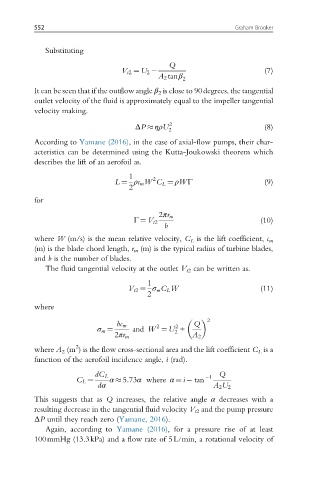Page 559 - Handbook of Biomechatronics
P. 559
552 Graham Brooker
Substituting
Q
V t2 ¼ U 2 (7)
A 2 tanβ 2
It can be seen that if the outflow angle β 2 is close to 90degrees, the tangential
outlet velocity of the fluid is approximately equal to the impeller tangential
velocity making.
ΔP ηρU 2 (8)
2
According to Yamane (2016), in the case of axial-flow pumps, their char-
acteristics can be determined using the Kutta-Joukowski theorem which
describes the lift of an aerofoil as.
1
L ¼ ρc m W C L ¼ ρWΓ (9)
2
2
for
2πr m
Γ ¼ V t2 (10)
b
where W (m/s) is the mean relative velocity, C L is the lift coefficient, c m
(m) is the blade chord length, r m (m) is the typical radius of turbine blades,
and b is the number of blades.
The fluid tangential velocity at the outlet V t2 can be written as.
1
V t2 ¼ σ m C L W (11)
2
where
2
Q
bc m 2 2
σ m ¼ and W ¼ U +
2
2πr m A 2
2
where A 2 (m ) is the flow cross-sectional area and the lift coefficient C L is a
function of the aerofoil incidence angle, i (rad).
Q
dC L 1
C L ¼ α 5:73α where α ¼ i tan
dα A 2 U 2
This suggests that as Q increases, the relative angle α decreases with a
resulting decrease in the tangential fluid velocity V t2 and the pump pressure
ΔP until they reach zero (Yamane, 2016).
Again, according to Yamane (2016), for a pressure rise of at least
100mmHg (13.3kPa) and a flow rate of 5L/min, a rotational velocity of

